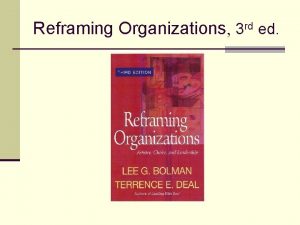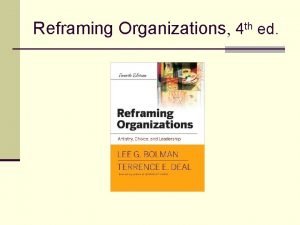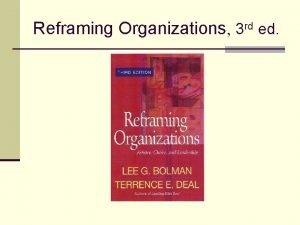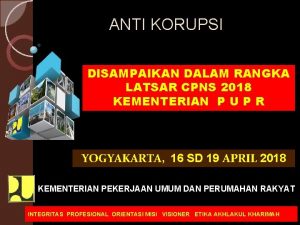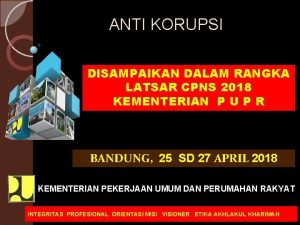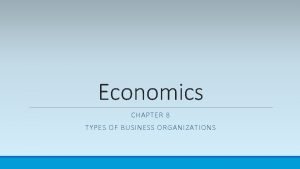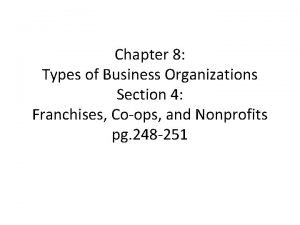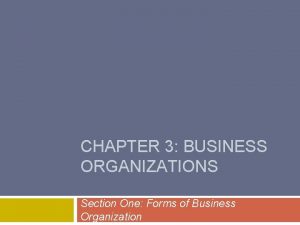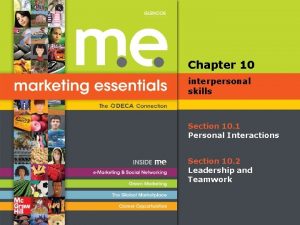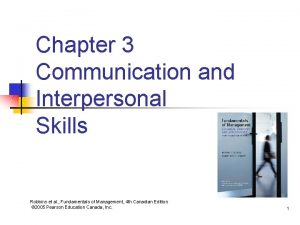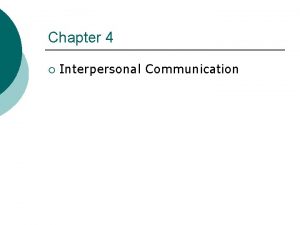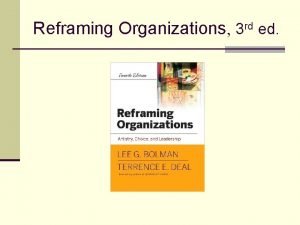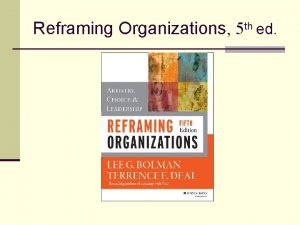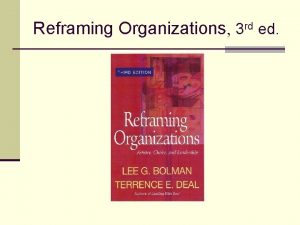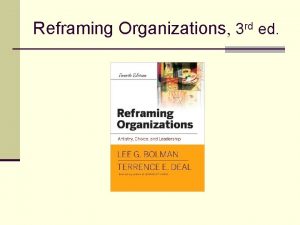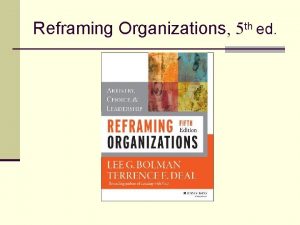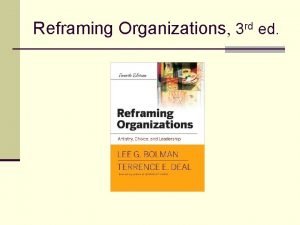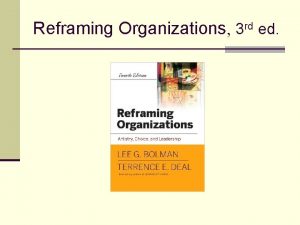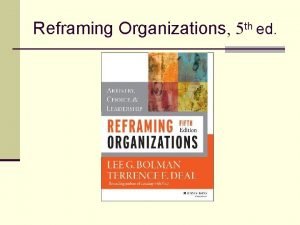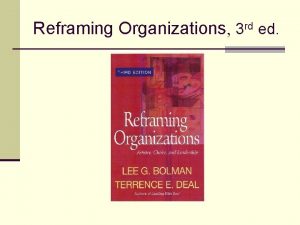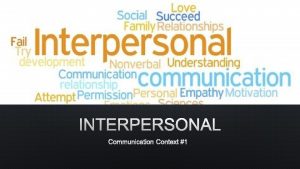Reframing Organizations 3 rd ed Chapter 8 Interpersonal



















- Slides: 19

Reframing Organizations, 3 rd ed.

Chapter 8 Interpersonal and Group Dynamics

Interpersonal and Group Dynamics n Interpersonal Dynamics n Management Styles n Group & Teams in Organizations

Interpersonal Dynamics n Managers spend much of their time in relationships n Three recurrent questions regularly haunt managers: What is really happening in this relationship? n Why do other people behave as they do? n What can I do about it? n

Interpersonal Dynamics (II) n Argyris and Schön’s theories for action n Espoused theory: how individuals describe, explain, or predict their own behavior n Theory-in-use: the program that governs an individual’s actions

Interpersonal Dynamics (II) n Argyris and Schön’s theories for action n Model I Theory in use n Model I Assumptions n n Model II Assumptions n n Problem is caused by others Unilateral diagnosis Get person to change Emphasize common goals Communicate openly Combine advocacy with inquiry The Perils of Self-Protection

Model I Theory-in-use Core values (governing variables) Action strategies Consequences for relationships Consequences for learning Define and achieve your own goals Design and manage unilaterally You’re seen as defensive, inconsistent, selfish Self-sealing Maximize winning, minimize losing Own and control what’s relevant to you You generate defensiveness Single-loop learning Avoid negative feelings Protect yourself You reinforce mistrust, conformity, avoiding risk Private testing of assumptions Be rational Unilaterally protect others Key issues become undiscussable Unconscious collusion to avoid learning

Model I Assumptions n Problems are caused by the other person n Since they caused the problem, get them to change n If they refuse or defend, that proves they caused the problem n If they resist, intensify the pressure, protect them (to avoid discomfort), or reject them n If you don’t succeed, it’s their fault; you’re not responsible

Model II Assumptions n Focus on common goals, mutual influence n Communicate openly, test beliefs publicly n Combine advocacy with inquiry

Advocacy & Inquiry Figure 8 -1: Advocacy and Inquiry. High Advocacy Low Assertive Integrative Passive Accommodating Inquiry

Emotional Intelligence n Emotional Intelligence: awareness of self and others, able to deal with emotions and relationships (Salovey and Mayer) n A Management Best-seller: Daniel Goleman’s Emotional Intelligence EI more important than IQ to managerial success n Individuals with low EI and high IQ are dangerous in the workplace n

Management Styles n Lewin, Lippitt and White: autocratic, democratic and laissez-faire leadership n Fleishman and Harris: initiating structure vs. consideration of others n Myers-Briggs Inventory Introversion vs. extraversion n Sensing vs. intuition n Thinking vs. feeling n Judging vs. perceiving n

Management Styles (II) n “Big 5 Model” n Extraversion (enjoying other people and seeking them out) n Agreeableness (getting along with others) n Conscientiousness (orderly, planful, hardworking) n Neuroticism (difficulty controlling negative feelings) n Openness to experience (preference for novelty and creativity)

Groups and Teams in Organizations n Informal Roles n Informal Group Norms n Interpersonal Conflict in Groups n Leadership and Decision-Making in Groups

Informal roles n Informal role: an unwritten, often unspoken expectation about how a particular individual will behave in the group n Individuals prefer different roles: some prefer to be active and in control, others prefer to stay in the background n Individuals who can’t find a comfortable role may withdraw or become troublemakers n Individuals may compete over the same role (for example, two people who both want to run things), hindering group effectiveness

Informal group norms n Informal norm: unwritten rule about what individuals have to do to be members in good standing n Norms need to align with both the task and the preferences of group members n Norms often develop unconsciously; groups often do better to discuss explicitly how they want to operate

Handling Interpersonal Conflict in Groups n Develop skills n Agree on basics n Search for interests in common n Experiment n Doubt your infallibility n Treat conflict as a group responsibility

Leadership and Decision-making in Groups n How will we steer the group n Leadership in the essential, but may be shared and fluid n Leaders who overcontrol or understructure produce frustration, ineffectiveness

Summary n Employees bring social and personal needs to the workplace n Individuals’ social skills or competencies are a critical element n Though often frustrating, groups can be both satisfying and efficient
 Reframing organizations chapter 3 summary
Reframing organizations chapter 3 summary Reframing organizations (doc or html) file
Reframing organizations (doc or html) file Reframing organizational culture
Reframing organizational culture Identifikasi dan penyelarasan nilai-nilai anti korupsi
Identifikasi dan penyelarasan nilai-nilai anti korupsi Teknik dasar konseling
Teknik dasar konseling Peran tunas integritas wow effect
Peran tunas integritas wow effect Nlp reframing
Nlp reframing Chapter 8 business organizations
Chapter 8 business organizations Chapter 8 section 4 other organizations
Chapter 8 section 4 other organizations Chapter 8 section 4 other organizations
Chapter 8 section 4 other organizations Introduction to management chapter 1
Introduction to management chapter 1 Chapter 3 information systems organizations and strategy
Chapter 3 information systems organizations and strategy Chapter 3 business organizations
Chapter 3 business organizations 6 interpersonal skills
6 interpersonal skills 10 interpersonal skills
10 interpersonal skills Chapter 5 interpersonal communication
Chapter 5 interpersonal communication Interpersonal communication chapter 3
Interpersonal communication chapter 3 Noise in interpersonal communication
Noise in interpersonal communication Define interpersonal communication
Define interpersonal communication Interpersonal skills in marketing
Interpersonal skills in marketing
